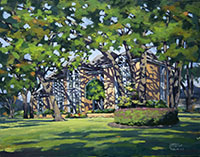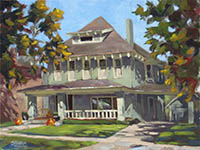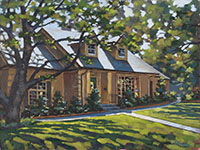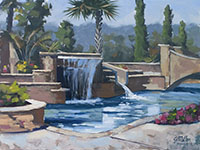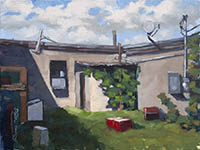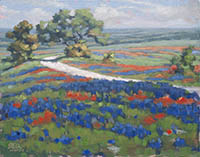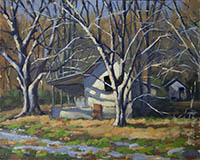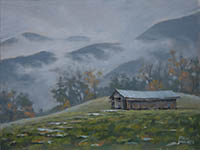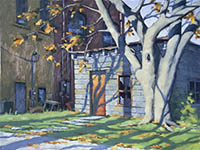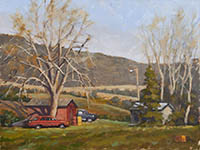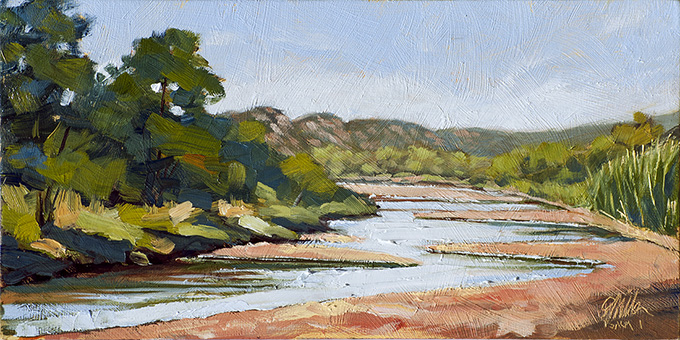
6 x 12 Plein Air oil on panel titled “Down River” – SMiller
Memorial Day, 2018, found my wife and I and two close friends on the Pease River in the south eastern part of the Texas panhandle. I have always loved this area ever since my artist friend, Pete Quaid, introduced me to it several years ago. The Texas panhandle has its own unique beauty.
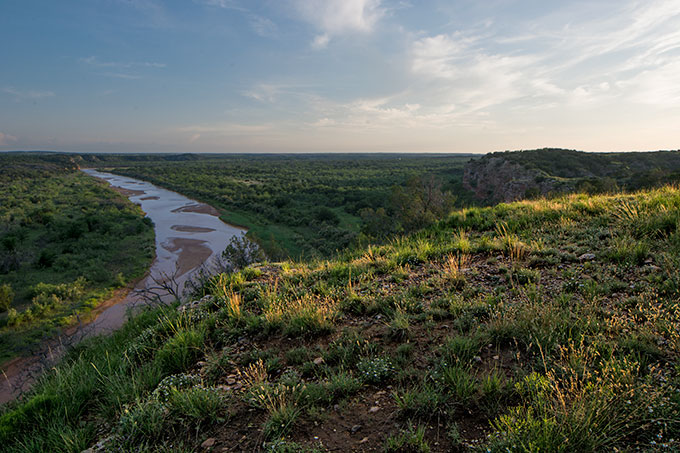
Photo: Pease River Overlook
My wife and I visit the Pease River to get away from the congested and hectic city life. I work on trying to improve painting skills, and she to walk the river bed in search of that “wow” photo. (DonnaMillerPhotos.com) The Pease River is a shallow, wide river that is more sand then water. It is made up of three tributaries that combine forces just west of the location we were in.
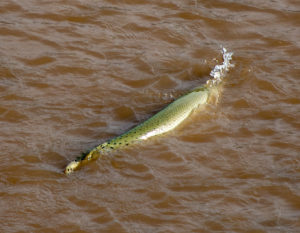
Spotted Gar in Pease River (photo by Donna Miller)
Although the majority of the river is 4 to 6 inches deep, flowing over a cool bed of sand, there are pockets that apparently are home to some large fish.
We saw a 3 foot spotted gar that had apparently been washed out of its “hole” during an overnight rain storm up river. I have seen video of decent sized, largemouth bass and a variety of sun fish that also call the river home.
The area I love to paint is a few miles upstream from the location where Cynthia Parker was “rescued” in December of 1860. Cynthia was abducted in 1836 when Fort Parker was attacked by Caddo, Comanche and Kiowa. Members of Cynthia’s family were killed, and 4 others were taken captive during what was called the Fort Parker Massacre. Cynthia lived with the Comanche’s for nearly 35 years, marrying a young chief named Peta Nocoma, who she had three children with. One of Cynthia’s sons, Quanah, was appointed as principal chief of the entire Comanche nation by the Federal government, and he also gained wealth as a rancher. The Texas town of Quanah was named after him.
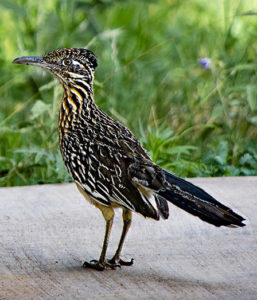
Roadrunner (photo by Donna Miller)
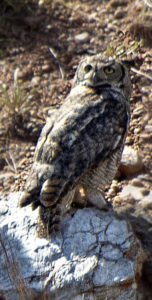
Great Horned Owl (Photo by Donna Miller)
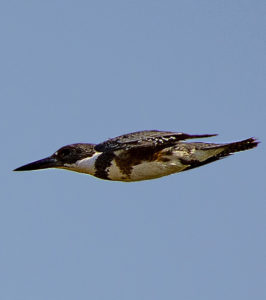
Kingfisher (photo by Donna Miller)
The Pease River area is also full of wildlife – deer, hogs, bobcats, snakes, roadrunners, owls and kingfishers just to name a few. While I am painting, my wife sets out on little “photo adventures” – walking up and down the sandy river bed shooting photos of various things she comes across. On this outing she came across a nesting Great Horned Owl, which had a wing span of about 4 feet.
She also shot photos of a roadrunner that was hanging around the cabin we stayed in and a kingfisher hunting its breakfast in the river. While she wanders the river bed with her camera, Pete Quaid and I set up and paint. Pete was thinking ahead this trip and brought and set up an awning to ease the heat of the sun. Excellent idea.
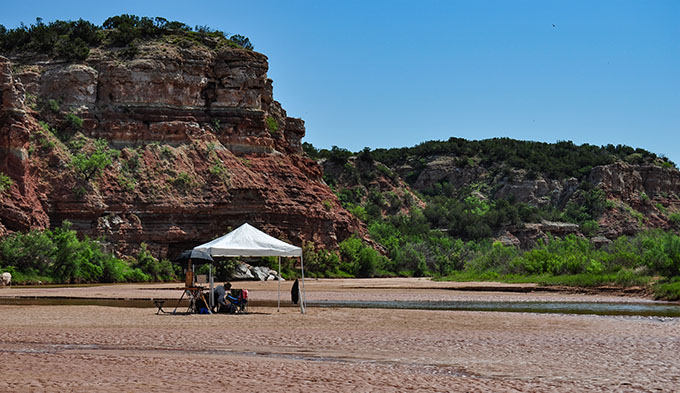
The Paint “camp”. Pete Quaid painting in the Pease River
I painted three small paintings, which, as always, were a challenge. But as they say, “nothing ventured, nothing gained”, so I do my best to welcome the learning experience.
When I am out in areas like this, I tend to ponder many things. Visuals are a huge part of the communication in the Bible, and the Pease River area is rich with imagery that continually turns my thoughts back to scripture and the “real” things of this life.
Psalm 19:1 says “The heavens are telling of the glory of God; And their expanse is declaring the work of His hands.” When I look out over the vast landscape of the Pease River valley, I see that “glory” mentioned in Psalm 19. I also see the curse of the fall of man, way back in Genesis. The land can be harsh. Stickers, heat, rattlesnakes and any numbers of creature and plants that bite, sting and stick. Romans 8 says that “For the creation was subjected to futility…” and that “we know that the whole creation groans and suffers the pains of childbirth…”
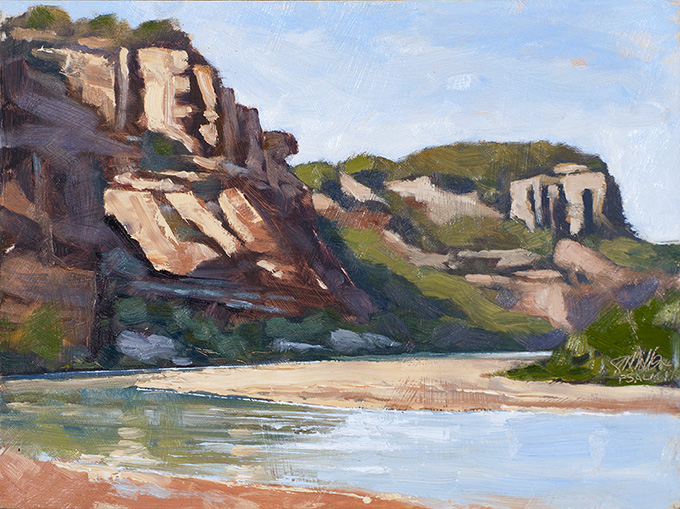
12 x 9 plein air oil on panel titled Sculpture Garden – SMiller
Mixed in with the beauty of the seemingly adversarial landscape, you can see this groaning and futility. However, as they say in the infomercials on TV “but wait, there is more…” When I look out on the southern panhandle that the Pease River cuts its way through, I also see God’s Grace. Winding like a snake through the cliffs and hills is life giving water. An oasis in the desert. God supplies water in a parched land. The Bible uses language like “dry”, “parched” and “thirsty” to describe life without Him.
Psalm 68:6 says this: “God makes a home for the lonely; He leads out the prisoners into prosperity, Only the rebellious dwell in a parched land. “
Enter God’s mercy and grace. “For He has satisfied the thirsty soul, And the hungry soul He has filled with what is good.” Psalm 107:9
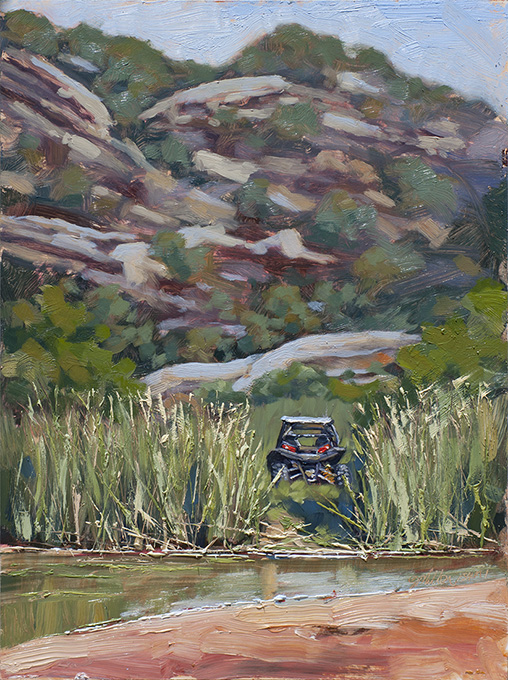
9 x 12 Plein air oil on panel titled “Four Wheeling” -SMiller
Jesus continued this imagery in the New Testament while talking to the woman at the well in John 4:13 and 14 “Jesus answered and said to her, “Everyone who drinks of this water will thirst again; but whoever drinks of the water that I will give him shall never thirst; but the water that I will give him will become in him a well of water springing up to eternal life.” Jesus is the “Water” in a dry land. The Water that quenches the spiritual thirst. This illustration is also seen again in Revelation 22:17 “The Spirit and the bride say, “Come.” And let the one who hears say, “Come.” And let the one who is thirsty come; let the one who wishes take the water of life without cost.”
Although I do hope to learn a bit about painting every time I go out on a paint outing, I also love how God speaks through His creation… the visual lessons mentioned in scripture. All because He loves us and wants us to come and drink of the “Water of Life”.


